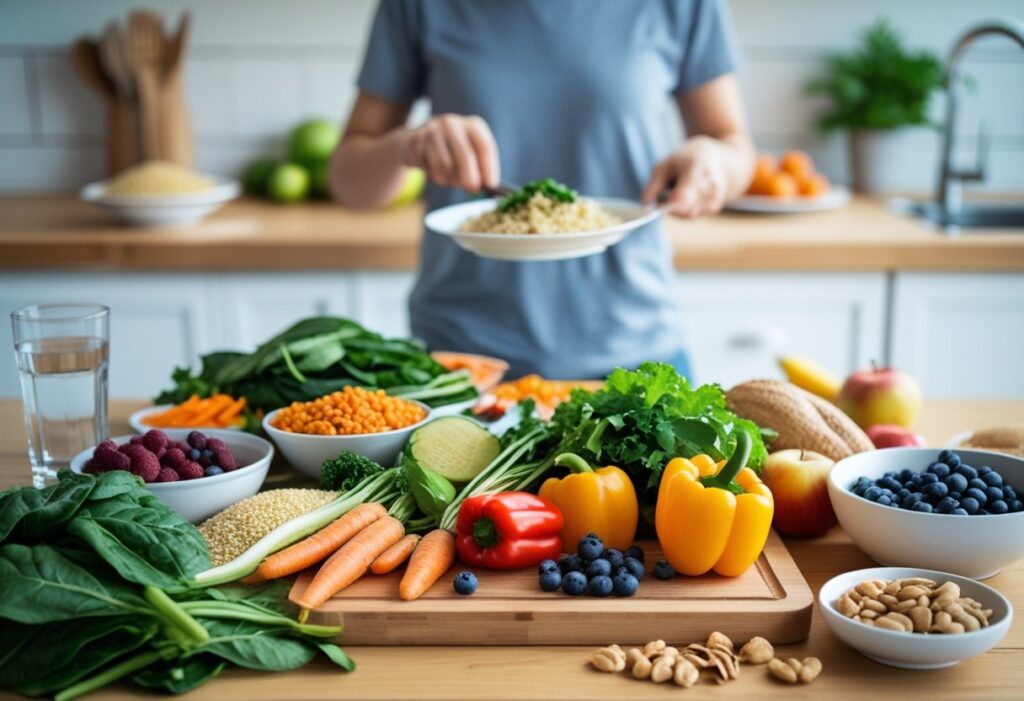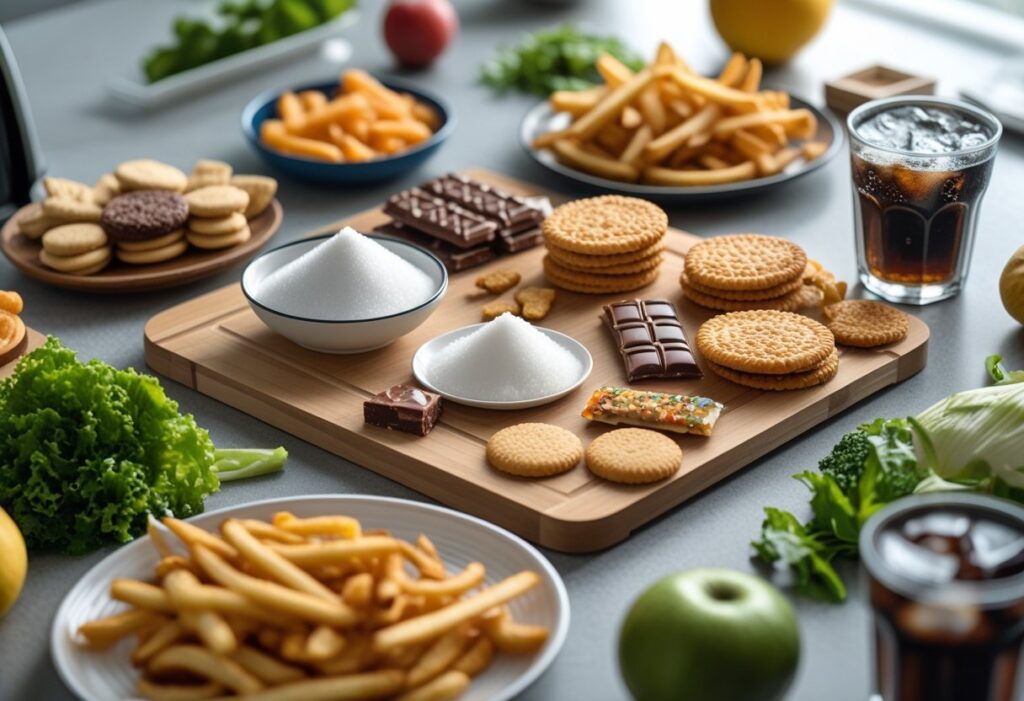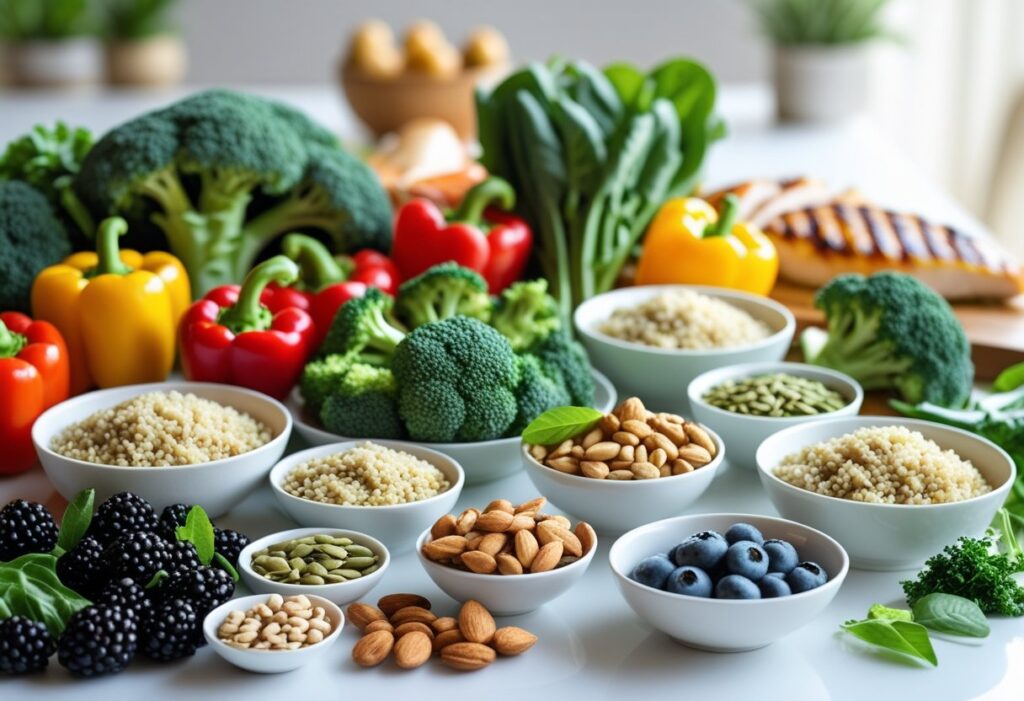Type 2 diabetes affects millions of people worldwide. Diet plays a crucial role in both preventing and managing this condition.
People with type 2 diabetes should avoid refined sugars, processed foods, white bread, sugary drinks, and foods high in saturated fats to help keep blood sugar levels stable.
Making the right food choices can really impact blood glucose control and overall health outcomes.
If you want better diabetes management, start by learning which foods to limit or cut out. Some foods spike blood sugar fast, while others give you steady energy and help keep levels more even.
The link between what you eat and how your blood sugar responds is at the heart of diabetes prevention and treatment. It’s not rocket science, but it does take a bit of attention.
Key Takeaways
- Avoiding refined sugars, processed foods, and high-carb items helps prevent dangerous blood sugar spikes in people with type 2 diabetes.
- Choosing whole grains, lean proteins, and non-starchy veggies supports stable glucose levels and better diabetes management.
- Pairing smart food choices with regular exercise and portion control can really cut the risk of diabetes complications.
Understanding the Link Between Food and Type 2 Diabetes

Food choices have a direct impact on blood sugar and insulin response in people with type 2 diabetes. The glycemic index gives a sense of how foods will hit your glucose, while extra weight just makes insulin resistance worse.
How Food Choices Influence Blood Sugar Levels
Every single thing you eat changes your blood sugar, but carbs have the biggest effect. The body turns carbs into sugar, so they’re the main players here.
Simple carbs like white bread and candy send blood sugar soaring in a hurry. Complex carbs from whole grains and veggies raise blood sugar much more slowly.
Protein and fat barely budge blood glucose. In fact, they can slow down sugar absorption if you eat them with carbs.
Knowing how food affects your blood sugar is step one for managing diabetes. People with type 2 diabetes really need to watch their carb intake.
Meal timing matters too. Eating smaller, regular meals helps avoid those wild blood sugar swings.
Role of Glycemic Index in Diabetes Management
The glycemic index ranks foods from 0 to 100, depending on how fast they raise blood sugar. High-glycemic foods make glucose shoot up quickly.
Low glycemic foods (55 or below):
- Most vegetables
- Beans and lentils
- Whole grains
- Most fruits
High glycemic foods (70 or above):
- White bread
- White rice
- Sugary drinks
- Most processed snacks
Whole grains usually have a lower glycemic index. That makes them a better pick than refined grains, hands down.
People with diabetes do best with low to moderate glycemic index foods. These help keep blood sugar steadier throughout the day.
Impact of Obesity and Weight Gain
Carrying extra weight makes type 2 diabetes a lot tougher to control. Fat, especially around the belly, makes your cells ignore insulin.
This is insulin resistance. The pancreas has to work overtime to crank out enough insulin to keep blood sugar in check.
Weight loss perks include:
- Better insulin sensitivity
- Lower blood sugar
- Needing less medication
- Lower risk of complications
Eating well also helps you hit a healthy weight, which means fewer diabetes complications. Even dropping just 5-10% of your weight can make a noticeable difference.
If you want to manage your weight, eat fewer calories than you burn. A small calorie deficit leads to slow, steady weight loss—no crash diets here.
Importance of Consulting a Registered Dietitian
A registered dietitian knows nutrition inside and out. They can create meal plans that actually fit you and your lifestyle.
What a dietitian brings to the table:
- Personalized meal planning
- Carb counting help
- Reading nutrition labels
- Tips for eating out
- Support with weight goals
A dietitian or doctor can help you build a food plan that actually works for you. That’s way better than some generic diet advice from the internet.
Lots of insurance plans actually cover visits with dietitians for diabetes. Ask your healthcare provider about a referral if you’re not sure.
Dietitians also help if you’ve got diabetes plus other health issues. They know how to juggle multiple dietary needs without making things complicated or unsafe.
Foods and Ingredients to Limit or Avoid

People with type 2 diabetes should limit packaged and fast foods, sugary snacks, and white bread, pasta, and rice to keep blood sugar in check. Cutting back on added sugars, refined grains, bad fats, and extra salt helps prevent blood sugar spikes and keeps you healthier overall.
Added Sugar and Sugary Foods
Added sugars make blood sugar jump fast, and they’re tough to manage. These sweeteners sneak into all sorts of products under a bunch of different names.
Common added sugar sources:
- Cakes and cookies
- Pies and baked goods
- Ice cream and candy
- Sugary drinks and energy drinks
- Sweetened cereals
If you have diabetes, skip sugar in candy, ice cream, and cakes. Sugar hides under names like corn syrup, fructose, and dextrose, so check labels.
Reading nutrition labels can help you spot hidden sugars. If sugar is near the top of the ingredients list, there’s a lot of it in there.
Refined Grains and Simple Carbohydrates
Refined grains lose most of their fiber and nutrients during processing. They digest fast and spike your blood sugar.
Foods to cut back on:
- White bread
- White rice
- White pasta
- Crackers
- Sugary cereals
Avoid bleached and refined carbs—they usually have a high glycemic index. Simple carbs break down quickly and don’t do you any favors.
Instead, try whole grain bread (look for at least 3 grams of fiber per slice) and 100% whole wheat pasta. These options have more fiber and digest more slowly.
Unhealthy Fats and Processed Meats
Trans fats and too much saturated fat cause inflammation and raise your risk of heart disease. Processed meats are loaded with sodium and preservatives.
Processed meats to limit:
- Bacon
- Ham
- Sausages
- Deli meats
Fast foods usually have unhealthy fats and processed meats. They don’t give you much nutrition but can mess with your blood sugar and cholesterol.
If you have diabetes, cut back on red and processed meats. Lean proteins like skinless chicken breast or fish are better bets.
Excess Salt and High-Sodium Snacks
Too much salt raises blood pressure, and that’s already a concern for many with diabetes. Processed foods pack in way more sodium than fresh foods.
High-sodium foods:
- Packaged snacks
- Canned soups
- Frozen meals
- Fast food
If you have diabetes and high blood pressure, go for foods with less sodium. Look for products with less than 140 mg of sodium per serving on the label.
Fresh veggies, fruits, and home-cooked meals naturally have less salt. Herbs and spices bring flavor without the sodium overload.
Recommended Foods for Stable Blood Sugar
Eating the right foods helps keep your blood sugar steady all day. Foods high in protein, fiber, and micronutrients like magnesium are your best friends for blood sugar control.
Whole Grains and Fiber-Rich Foods
Whole grains give you steady energy and don’t cause blood sugar spikes. Research says eating more whole grains can lower your risk of type 2 diabetes.
Brown rice has more fiber than white rice. It digests slowly and helps keep blood sugar on an even keel.
Quinoa is packed with complete protein and fiber. It’s a solid choice for salads and side dishes.
Oats can help lower cholesterol and give you lasting energy. Steel-cut oats beat instant ones for fiber content.
Other good picks:
- Barley
- Millet
- Farro
- 100% whole wheat bread
Fiber slows digestion and stops blood sugar from spiking. Adults should aim for about 30 grams of fiber daily—easier said than done, but worth it.
Healthy Proteins and Plant-Based Choices
Protein keeps you full longer and helps steady blood sugar. Lean poultry, fish, and plant sources like beans and lentils work well for diabetes management.
Beans and lentils give you protein and fiber. Black beans, kidney beans, and chickpeas are easy to mix into meals.
Fish like salmon, tuna, and mackerel pack in healthy omega-3 fats. These fish support heart health and provide solid protein.
Chicken and turkey offer lean protein without extra carbs. Pull off the skin to cut down on saturated fat.
Eggs bring complete protein and nutrients. You can eat them for breakfast, lunch, or dinner—eggs are pretty flexible.
Plant-based proteins are also worth considering:
- Tofu – soaks up flavors in stir-fries
- Tempeh – fermented, with some probiotics
- Nuts and seeds – almonds, walnuts, chia seeds
Fruit, Vegetables, and Nutrient-Dense Options
Fruits and vegetables deliver vitamins, minerals, and fiber. Whole fruits have fiber with their natural sugars, which slows digestion.
Non-starchy vegetables barely budge blood sugar:
- Leafy greens
- Broccoli
- Bell peppers
- Cauliflower
- Tomatoes
Starchy vegetables have more carbs, so watch your portions:
- Sweet potatoes
- Corn
- Winter squash
Fruits give you natural sweetness and fiber. Apples, berries, grapes, and citrus are usually smart picks.
Frozen veggies can be just as nutritious as fresh. Canned ones work too—just check for no added salt or sugar.
Choosing Healthy Fats and Dairy
The right fats help your heart and keep blood sugar in check. Unsaturated fats from plant foods are especially helpful for blood sugar and heart health.
Avocados have fiber and healthy monounsaturated fats. Toss them in salads, sandwiches, or just eat them as a snack.
Olive oil is a go-to for healthy fats in cooking or dressings. Extra virgin olive oil usually brings the most benefits.
Nuts and seeds provide protein, fiber, and healthy fats too:
- Almonds offer vitamin E and magnesium
- Walnuts are rich in omega-3s
- Chia seeds give you fiber and protein
Dairy choices should lean toward lower-fat options. Plain yogurt (without extra sugar) delivers calcium and protein. Low-fat milk and cheese do the same.
Non-dairy milks like soy, almond, or oat can work, but check labels for added sugars since some brands sneak them in.
Lifestyle Strategies for Reducing Diabetes Risk
Making smart decisions about drinks, portions, and food can really lower your type 2 diabetes risk. If you can read nutrition labels and team up with a healthcare pro, you’ll set yourself up for lasting changes.
Smart Beverage Choices
Sugary drinks raise type 2 diabetes risk a lot. Soda, energy drinks, and sweetened drinks are packed with added sugar that quickly spikes blood sugar.
Better Options Include:
- Plain water
- Unsweetened tea and coffee
- Sugar-free drinks with artificial sweeteners
- Plain milk
Fruit juice has about as much sugar as soda. Even 100% juice misses the fibre from whole fruit, so blood sugar climbs fast after drinking it.
Don’t swap out soda for juice or smoothies. They’re still full of free sugar, which can lead to weight gain.
Artificial sweeteners in diet drinks offer sweetness without calories. If you swap them for regular soda, you can cut calories without giving up taste.
Portion Control and Mindful Eating
Keeping portions in check helps manage calories and prevents unwanted weight gain. Even healthy foods can add up if you eat too much.
Portion Guidelines:
- Try smaller plates and bowls
- Fill half your plate with veggies
- Limit carbs to a quarter of your plate
- Include lean protein in every meal
Mindful eating means noticing hunger and fullness cues. Eat slowly, and maybe turn off the TV or put down your phone during meals.
Restaurant menus can be tricky. Portions are often double or triple what you need.
Measuring food at first helps you get a feel for portion sizes. Over time, you’ll be able to eyeball it without the measuring cups.
Reading Food Labels
Food labels tell you what’s in your food—sugar, fiber, sodium, and more. Comparing similar items helps you pick the healthier one.
Key Label Information:
- Total carbs and added sugars
- Fibre per serving
- Sodium content
- Serving size and servings per package
Checking labels can reveal highly processed foods loaded with sugar, fat, and salt. Fewer ingredients usually means less processing.
Ingredients are listed by weight. Sugar hides under names like high fructose corn syrup, dextrose, or maltose.
Look for fiber—3 grams or more per serving means better blood sugar control than low-fiber foods.
Regular Monitoring and Professional Guidance
Registered dietitians give advice that’s tailored to you. They can help you build a meal plan that fits your tastes and health needs.
Health screenings track blood pressure, cholesterol, and blood sugar. Catching problems early means you can act before diabetes sets in.
Your healthcare provider can check risk factors like family history and weight. They’ll suggest changes based on your unique profile.
Professional Services Include:
- Nutritional counselling
- Weight management programs
- Diabetes prevention programs
- Regular health assessments
Insurance often covers nutrition counselling for diabetes prevention. Prevention programs help people keep up healthy eating habits for the long haul.
Healthcare teams can connect the dots between your diet and conditions like heart disease or cancer. It’s a more complete way to tackle several health risks at once.
Frequently Asked Questions
People with type 2 diabetes usually wonder which foods spike blood sugar fastest and which habits make things worse. Knowing about refined carbs, sugary drinks, and processed foods can help you make smarter choices.
What are the top foods known to increase blood sugar levels?
Sugary drinks top the list for blood sugar spikes. Sodas, fruit juices, and energy drinks are basically concentrated sugar that hits your bloodstream fast.
White bread and refined grains cause big blood sugar jumps. These refined carbohydrates break down into glucose almost instantly.
Candy and sweets? They’re just pure sugar, no real nutrition. Hard candies, gummies, and chocolate bars all flood your system with glucose within minutes.
Pastries and baked goods mix refined flour with sugar. Donuts, muffins, and cookies hit you with both simple and complex carbs—double trouble for blood sugar.
Which dietary choices can negatively impact glycemic control in individuals with type 2 diabetes?
Eating big portions at random times throws blood sugar off. Skipping meals, then overeating later, leads to wild swings in glucose.
Processed foods are another problem. Packaged and fast foods hide sugars and refined ingredients that can spike blood sugar out of nowhere.
Drinking alcohol on an empty stomach can make blood sugar crash. Alcohol gets in the way of your liver releasing stored glucose when you need it.
Eating high-carb foods without any protein or fiber makes glucose hit faster. Pasta alone raises blood sugar more than pasta with veggies and lean protein.
Can you identify specific food groups that should be minimized to manage type 2 diabetes effectively?
Refined grains are best kept to a minimum. White pasta, rice, and bread lack fibre and spike blood sugar fast.
Sugary drinks are the worst offenders for diabetics. Soda, fruit punch, and sweetened coffee drinks are all sugar with no lasting fullness.
Processed meats bring lots of sodium and preservatives, which can make diabetes complications worse. Hot dogs, bacon, and deli meats also raise heart disease risk.
Fried foods are loaded with calories and unhealthy fats. French fries and fried snacks add pounds and boost insulin resistance.
What are some common foods that may exacerbate type 2 diabetes symptoms?
Breakfast cereals can have more sugar than candy. Some popular brands have 10-15 grams of added sugar per serving, which can spike morning blood sugar.
Flavoured yogurts hide a lot of sugar. Regular fruit yogurt might have 20-30 grams—about the same as a candy bar.
Dried fruits cram natural sugars into small bites. Raisins, dates, and dried cranberries can overload your system if you’re not careful.
Restaurant meals often sneak in extra sugar and serve huge portions. Sauces, marinades, and dressings can add carbs to dishes that seem healthy at first glance.
Are there any surprising food items that diabetics should be cautious about consuming?
Granola and health bars often look healthy but are packed with sugar. Honey, dried fruit, and syrups can send blood sugar soaring.
Smoothies sometimes contain as much sugar as several pieces of fruit. Blending breaks down the fiber, so your body absorbs the sugar faster than if you ate whole fruit.
Low-fat products can be sneaky. Fat-free yogurt and reduced-fat dressings often swap fat for sugar, sometimes making them worse than the full-fat versions.
Condiments and sauces—think ketchup, barbecue sauce, or teriyaki—add hidden sugars to meals. It’s easy to overlook, but they add up quickly.
What are the dietary recommendations for someone looking to prevent the progression of pre-diabetes to type 2 diabetes?
Honestly, I’d say start with whole foods from all the major food groups. Vegetables, fruits, whole grains, and lean proteins pack in the nutrients you need and help keep blood sugar stable.
Go for foods high in fibre—think beans, lentils, and those hearty whole grains. Fibre slows down how fast your body absorbs glucose and helps you feel full longer.
Try to keep portions reasonable and eat at regular times. Sticking with consistent meals makes it easier for your body to manage blood sugar.
And don’t forget about moving your body. Regular exercise boosts insulin sensitivity and helps your muscles use glucose better.



